Business Environment Analysis Report - January 2021 - March 2021
VerifiedAdded on 2022/12/28
|10
|2624
|70
Report
AI Summary
This report provides a comprehensive analysis of the business environment, focusing on Coca-Cola and Pepsi. It begins with an introduction to micro and macro environments and their impact on businesses. The main body delves into organizational types, sizes, and scopes, comparing public, private, and voluntary sectors with examples like the BBC and Coca-Cola. The report examines Coca-Cola's organizational structure, size, and scope, linking them to its business objectives and product offerings. It further explores the relationship between different organizational functions and their impact on organizational objectives and structure. The report also highlights the advantages and disadvantages of these relationships. The analysis incorporates a PESTLE and SWOT analysis (implied in the brief) to assess external factors and internal strengths/weaknesses. The conclusion summarizes key findings, and references are provided. The report aims to provide a detailed understanding of how environmental factors influence the operations and strategies of Coca-Cola and Pepsi within the beverage industry.
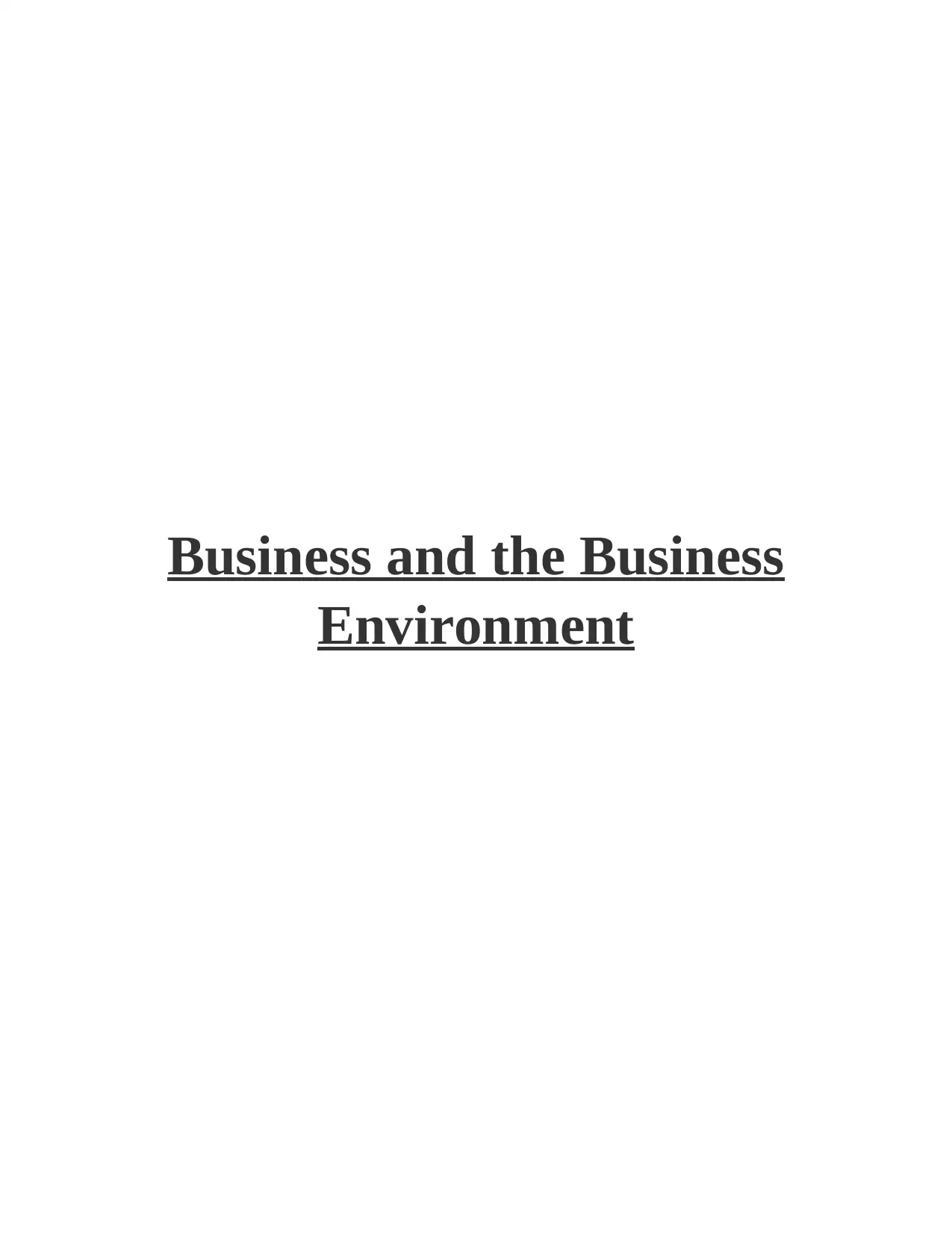
Business and the Business
Environment
Environment
Paraphrase This Document
Need a fresh take? Get an instant paraphrase of this document with our AI Paraphraser
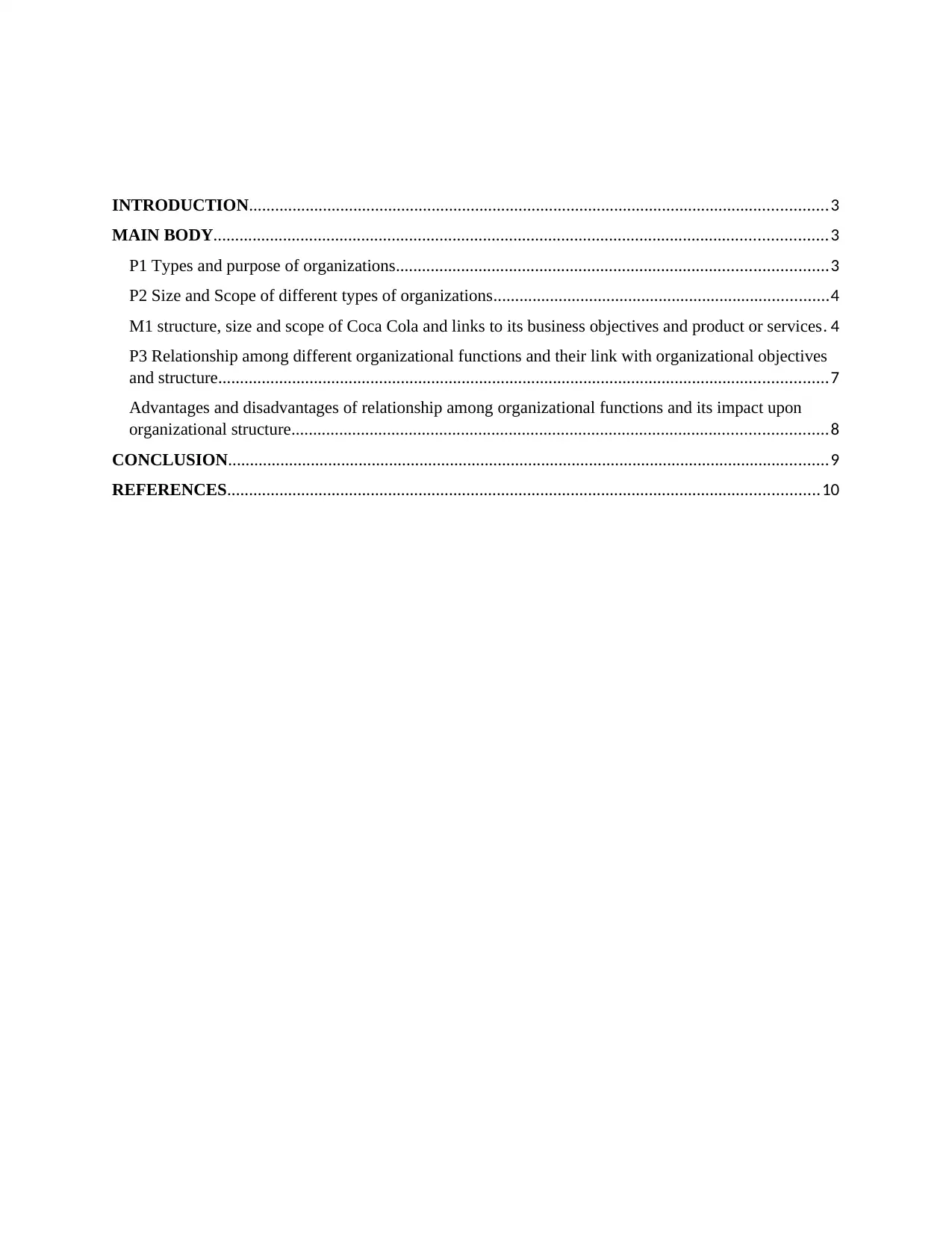
INTRODUCTION.....................................................................................................................................3
MAIN BODY.............................................................................................................................................3
P1 Types and purpose of organizations...................................................................................................3
P2 Size and Scope of different types of organizations.............................................................................4
M1 structure, size and scope of Coca Cola and links to its business objectives and product or services. 4
P3 Relationship among different organizational functions and their link with organizational objectives
and structure............................................................................................................................................7
Advantages and disadvantages of relationship among organizational functions and its impact upon
organizational structure...........................................................................................................................8
CONCLUSION..........................................................................................................................................9
REFERENCES........................................................................................................................................10
MAIN BODY.............................................................................................................................................3
P1 Types and purpose of organizations...................................................................................................3
P2 Size and Scope of different types of organizations.............................................................................4
M1 structure, size and scope of Coca Cola and links to its business objectives and product or services. 4
P3 Relationship among different organizational functions and their link with organizational objectives
and structure............................................................................................................................................7
Advantages and disadvantages of relationship among organizational functions and its impact upon
organizational structure...........................................................................................................................8
CONCLUSION..........................................................................................................................................9
REFERENCES........................................................................................................................................10
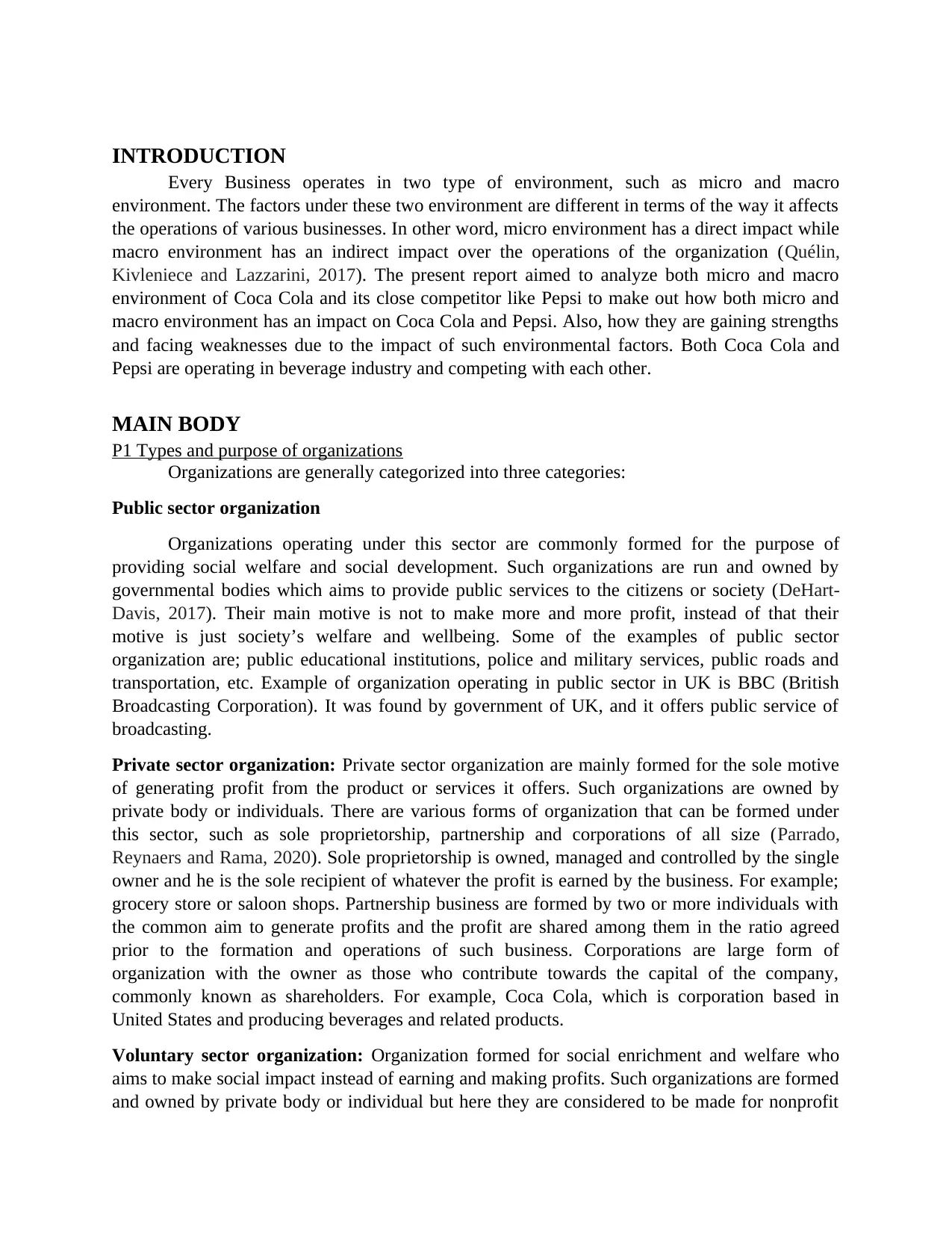
INTRODUCTION
Every Business operates in two type of environment, such as micro and macro
environment. The factors under these two environment are different in terms of the way it affects
the operations of various businesses. In other word, micro environment has a direct impact while
macro environment has an indirect impact over the operations of the organization (Quélin,
Kivleniece and Lazzarini, 2017). The present report aimed to analyze both micro and macro
environment of Coca Cola and its close competitor like Pepsi to make out how both micro and
macro environment has an impact on Coca Cola and Pepsi. Also, how they are gaining strengths
and facing weaknesses due to the impact of such environmental factors. Both Coca Cola and
Pepsi are operating in beverage industry and competing with each other.
MAIN BODY
P1 Types and purpose of organizations
Organizations are generally categorized into three categories:
Public sector organization
Organizations operating under this sector are commonly formed for the purpose of
providing social welfare and social development. Such organizations are run and owned by
governmental bodies which aims to provide public services to the citizens or society (DeHart-
Davis, 2017). Their main motive is not to make more and more profit, instead of that their
motive is just society’s welfare and wellbeing. Some of the examples of public sector
organization are; public educational institutions, police and military services, public roads and
transportation, etc. Example of organization operating in public sector in UK is BBC (British
Broadcasting Corporation). It was found by government of UK, and it offers public service of
broadcasting.
Private sector organization: Private sector organization are mainly formed for the sole motive
of generating profit from the product or services it offers. Such organizations are owned by
private body or individuals. There are various forms of organization that can be formed under
this sector, such as sole proprietorship, partnership and corporations of all size (Parrado,
Reynaers and Rama, 2020). Sole proprietorship is owned, managed and controlled by the single
owner and he is the sole recipient of whatever the profit is earned by the business. For example;
grocery store or saloon shops. Partnership business are formed by two or more individuals with
the common aim to generate profits and the profit are shared among them in the ratio agreed
prior to the formation and operations of such business. Corporations are large form of
organization with the owner as those who contribute towards the capital of the company,
commonly known as shareholders. For example, Coca Cola, which is corporation based in
United States and producing beverages and related products.
Voluntary sector organization: Organization formed for social enrichment and welfare who
aims to make social impact instead of earning and making profits. Such organizations are formed
and owned by private body or individual but here they are considered to be made for nonprofit
Every Business operates in two type of environment, such as micro and macro
environment. The factors under these two environment are different in terms of the way it affects
the operations of various businesses. In other word, micro environment has a direct impact while
macro environment has an indirect impact over the operations of the organization (Quélin,
Kivleniece and Lazzarini, 2017). The present report aimed to analyze both micro and macro
environment of Coca Cola and its close competitor like Pepsi to make out how both micro and
macro environment has an impact on Coca Cola and Pepsi. Also, how they are gaining strengths
and facing weaknesses due to the impact of such environmental factors. Both Coca Cola and
Pepsi are operating in beverage industry and competing with each other.
MAIN BODY
P1 Types and purpose of organizations
Organizations are generally categorized into three categories:
Public sector organization
Organizations operating under this sector are commonly formed for the purpose of
providing social welfare and social development. Such organizations are run and owned by
governmental bodies which aims to provide public services to the citizens or society (DeHart-
Davis, 2017). Their main motive is not to make more and more profit, instead of that their
motive is just society’s welfare and wellbeing. Some of the examples of public sector
organization are; public educational institutions, police and military services, public roads and
transportation, etc. Example of organization operating in public sector in UK is BBC (British
Broadcasting Corporation). It was found by government of UK, and it offers public service of
broadcasting.
Private sector organization: Private sector organization are mainly formed for the sole motive
of generating profit from the product or services it offers. Such organizations are owned by
private body or individuals. There are various forms of organization that can be formed under
this sector, such as sole proprietorship, partnership and corporations of all size (Parrado,
Reynaers and Rama, 2020). Sole proprietorship is owned, managed and controlled by the single
owner and he is the sole recipient of whatever the profit is earned by the business. For example;
grocery store or saloon shops. Partnership business are formed by two or more individuals with
the common aim to generate profits and the profit are shared among them in the ratio agreed
prior to the formation and operations of such business. Corporations are large form of
organization with the owner as those who contribute towards the capital of the company,
commonly known as shareholders. For example, Coca Cola, which is corporation based in
United States and producing beverages and related products.
Voluntary sector organization: Organization formed for social enrichment and welfare who
aims to make social impact instead of earning and making profits. Such organizations are formed
and owned by private body or individual but here they are considered to be made for nonprofit
⊘ This is a preview!⊘
Do you want full access?
Subscribe today to unlock all pages.

Trusted by 1+ million students worldwide
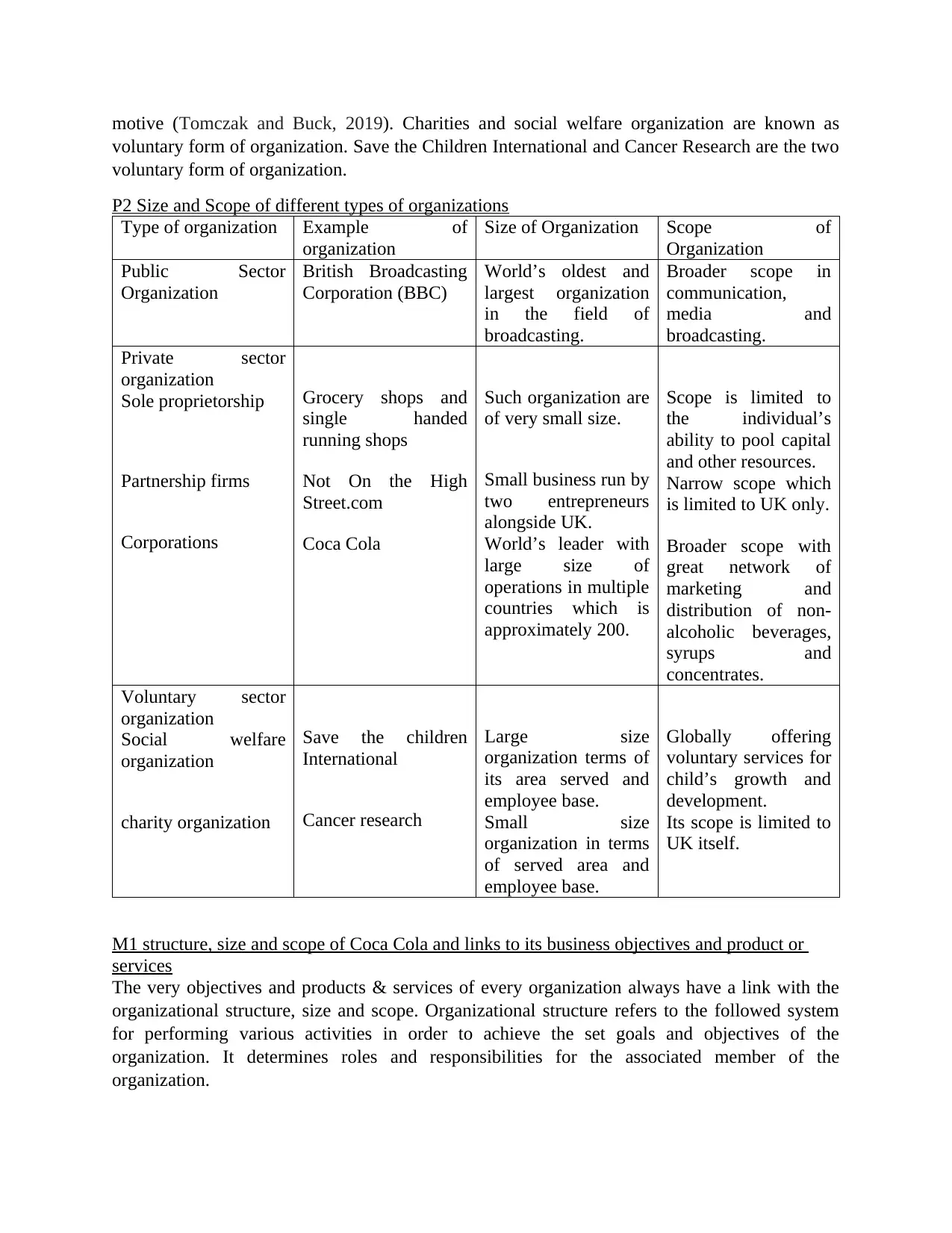
motive (Tomczak and Buck, 2019). Charities and social welfare organization are known as
voluntary form of organization. Save the Children International and Cancer Research are the two
voluntary form of organization.
P2 Size and Scope of different types of organizations
Type of organization Example of
organization
Size of Organization Scope of
Organization
Public Sector
Organization
British Broadcasting
Corporation (BBC)
World’s oldest and
largest organization
in the field of
broadcasting.
Broader scope in
communication,
media and
broadcasting.
Private sector
organization
Sole proprietorship
Partnership firms
Corporations
Grocery shops and
single handed
running shops
Not On the High
Street.com
Coca Cola
Such organization are
of very small size.
Small business run by
two entrepreneurs
alongside UK.
World’s leader with
large size of
operations in multiple
countries which is
approximately 200.
Scope is limited to
the individual’s
ability to pool capital
and other resources.
Narrow scope which
is limited to UK only.
Broader scope with
great network of
marketing and
distribution of non-
alcoholic beverages,
syrups and
concentrates.
Voluntary sector
organization
Social welfare
organization
charity organization
Save the children
International
Cancer research
Large size
organization terms of
its area served and
employee base.
Small size
organization in terms
of served area and
employee base.
Globally offering
voluntary services for
child’s growth and
development.
Its scope is limited to
UK itself.
M1 structure, size and scope of Coca Cola and links to its business objectives and product or
services
The very objectives and products & services of every organization always have a link with the
organizational structure, size and scope. Organizational structure refers to the followed system
for performing various activities in order to achieve the set goals and objectives of the
organization. It determines roles and responsibilities for the associated member of the
organization.
voluntary form of organization. Save the Children International and Cancer Research are the two
voluntary form of organization.
P2 Size and Scope of different types of organizations
Type of organization Example of
organization
Size of Organization Scope of
Organization
Public Sector
Organization
British Broadcasting
Corporation (BBC)
World’s oldest and
largest organization
in the field of
broadcasting.
Broader scope in
communication,
media and
broadcasting.
Private sector
organization
Sole proprietorship
Partnership firms
Corporations
Grocery shops and
single handed
running shops
Not On the High
Street.com
Coca Cola
Such organization are
of very small size.
Small business run by
two entrepreneurs
alongside UK.
World’s leader with
large size of
operations in multiple
countries which is
approximately 200.
Scope is limited to
the individual’s
ability to pool capital
and other resources.
Narrow scope which
is limited to UK only.
Broader scope with
great network of
marketing and
distribution of non-
alcoholic beverages,
syrups and
concentrates.
Voluntary sector
organization
Social welfare
organization
charity organization
Save the children
International
Cancer research
Large size
organization terms of
its area served and
employee base.
Small size
organization in terms
of served area and
employee base.
Globally offering
voluntary services for
child’s growth and
development.
Its scope is limited to
UK itself.
M1 structure, size and scope of Coca Cola and links to its business objectives and product or
services
The very objectives and products & services of every organization always have a link with the
organizational structure, size and scope. Organizational structure refers to the followed system
for performing various activities in order to achieve the set goals and objectives of the
organization. It determines roles and responsibilities for the associated member of the
organization.
Paraphrase This Document
Need a fresh take? Get an instant paraphrase of this document with our AI Paraphraser
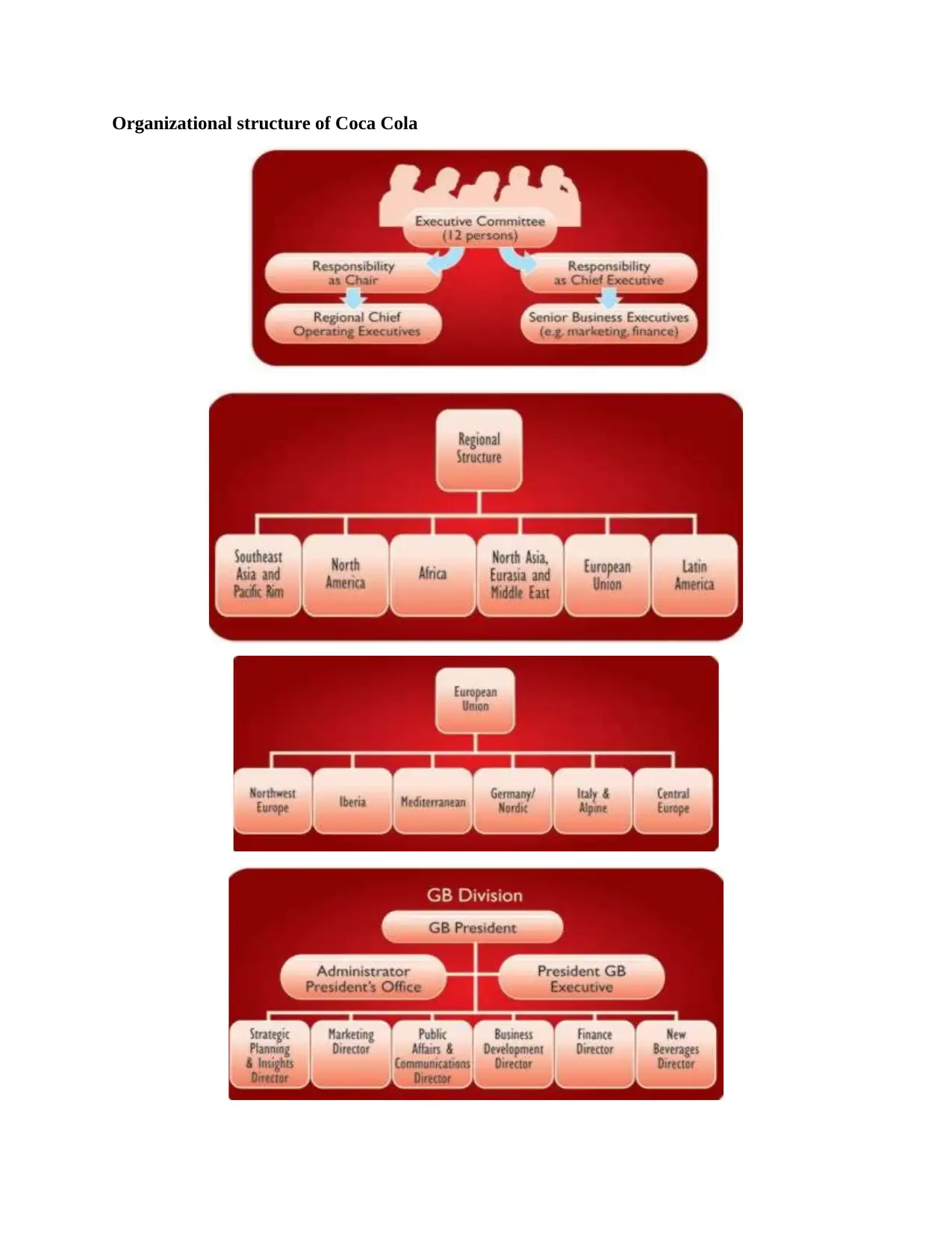
Organizational structure of Coca Cola

ORGANIZATIONAL STRUCTURE OF COCA COLA COMPANY
At the top there is 12 executives who are responsible for making strategies and decisions. Then
the chair person who are also chief executive officer responsible for heading the board meetings.
To connect with the local consumers, there is regional structure which ensures localization. The
has six Strategic business units for six different regions. These six SBUs has six different
divisions if European Union as a SBU will be taken, where UK operates in northwest division of
Europe. Also, this subsection of SBU are further divided into number of different functional
departments.
In this way organizational structure of Coca Cola has been designed in decentralized way where
different regional bodies are responsible for differentiating geographical needs, while the
decision making authority lies with top level of executives only reflecting centralized form of
decision making system. This unique structure of Coca Cola helps them in achieving their set
goals and objectives in a better way (Afeni, 2017).
Size of Coca Cola: Coca Cola is a world’s leading largest organization operating in beverages
and syrups and concentrates from which these non-alcoholic beverages are prepared are the main
business operations of coca Cola. It is considered to be large in terms of its serving and
operations in around 200 countries, and also by its revenue generation and employee base.
Scope of Coca Cola: Coca Cola in enjoying a very broad base of customers due to its scope of
expanding and diversifying strategies.
Organization frame their objectives after deciding upon their organizational structure. Higher
level objectives can only be set out if the organization and its management believes that they
have excellent structure within organization. If organization has set higher targets and their
employees don’t know anything about their roles, responsibilities and reporting system, then it
becomes impossible for such organization to reach their set objectives, as no one is clear about
their roles which leads to claiming one another for each unachieved tasks.
Also, every organization decide upon their objectives by keeping in their mind the size of
their organization. Only the very big and vast size of organization can be able to set huge targets,
where its size allows for larger investments and better utilization of resources. Every
At the top there is 12 executives who are responsible for making strategies and decisions. Then
the chair person who are also chief executive officer responsible for heading the board meetings.
To connect with the local consumers, there is regional structure which ensures localization. The
has six Strategic business units for six different regions. These six SBUs has six different
divisions if European Union as a SBU will be taken, where UK operates in northwest division of
Europe. Also, this subsection of SBU are further divided into number of different functional
departments.
In this way organizational structure of Coca Cola has been designed in decentralized way where
different regional bodies are responsible for differentiating geographical needs, while the
decision making authority lies with top level of executives only reflecting centralized form of
decision making system. This unique structure of Coca Cola helps them in achieving their set
goals and objectives in a better way (Afeni, 2017).
Size of Coca Cola: Coca Cola is a world’s leading largest organization operating in beverages
and syrups and concentrates from which these non-alcoholic beverages are prepared are the main
business operations of coca Cola. It is considered to be large in terms of its serving and
operations in around 200 countries, and also by its revenue generation and employee base.
Scope of Coca Cola: Coca Cola in enjoying a very broad base of customers due to its scope of
expanding and diversifying strategies.
Organization frame their objectives after deciding upon their organizational structure. Higher
level objectives can only be set out if the organization and its management believes that they
have excellent structure within organization. If organization has set higher targets and their
employees don’t know anything about their roles, responsibilities and reporting system, then it
becomes impossible for such organization to reach their set objectives, as no one is clear about
their roles which leads to claiming one another for each unachieved tasks.
Also, every organization decide upon their objectives by keeping in their mind the size of
their organization. Only the very big and vast size of organization can be able to set huge targets,
where its size allows for larger investments and better utilization of resources. Every
⊘ This is a preview!⊘
Do you want full access?
Subscribe today to unlock all pages.

Trusted by 1+ million students worldwide
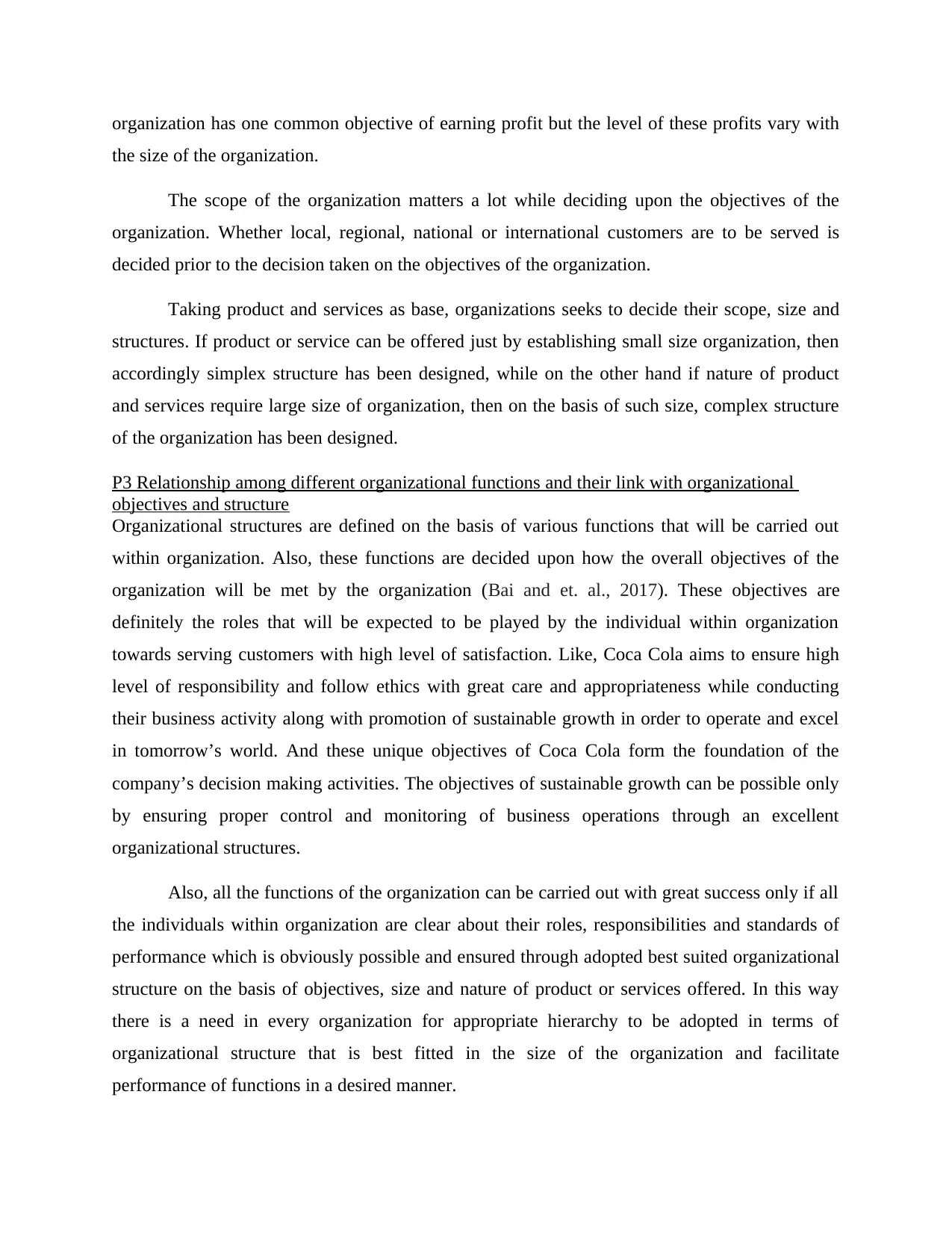
organization has one common objective of earning profit but the level of these profits vary with
the size of the organization.
The scope of the organization matters a lot while deciding upon the objectives of the
organization. Whether local, regional, national or international customers are to be served is
decided prior to the decision taken on the objectives of the organization.
Taking product and services as base, organizations seeks to decide their scope, size and
structures. If product or service can be offered just by establishing small size organization, then
accordingly simplex structure has been designed, while on the other hand if nature of product
and services require large size of organization, then on the basis of such size, complex structure
of the organization has been designed.
P3 Relationship among different organizational functions and their link with organizational
objectives and structure
Organizational structures are defined on the basis of various functions that will be carried out
within organization. Also, these functions are decided upon how the overall objectives of the
organization will be met by the organization (Bai and et. al., 2017). These objectives are
definitely the roles that will be expected to be played by the individual within organization
towards serving customers with high level of satisfaction. Like, Coca Cola aims to ensure high
level of responsibility and follow ethics with great care and appropriateness while conducting
their business activity along with promotion of sustainable growth in order to operate and excel
in tomorrow’s world. And these unique objectives of Coca Cola form the foundation of the
company’s decision making activities. The objectives of sustainable growth can be possible only
by ensuring proper control and monitoring of business operations through an excellent
organizational structures.
Also, all the functions of the organization can be carried out with great success only if all
the individuals within organization are clear about their roles, responsibilities and standards of
performance which is obviously possible and ensured through adopted best suited organizational
structure on the basis of objectives, size and nature of product or services offered. In this way
there is a need in every organization for appropriate hierarchy to be adopted in terms of
organizational structure that is best fitted in the size of the organization and facilitate
performance of functions in a desired manner.
the size of the organization.
The scope of the organization matters a lot while deciding upon the objectives of the
organization. Whether local, regional, national or international customers are to be served is
decided prior to the decision taken on the objectives of the organization.
Taking product and services as base, organizations seeks to decide their scope, size and
structures. If product or service can be offered just by establishing small size organization, then
accordingly simplex structure has been designed, while on the other hand if nature of product
and services require large size of organization, then on the basis of such size, complex structure
of the organization has been designed.
P3 Relationship among different organizational functions and their link with organizational
objectives and structure
Organizational structures are defined on the basis of various functions that will be carried out
within organization. Also, these functions are decided upon how the overall objectives of the
organization will be met by the organization (Bai and et. al., 2017). These objectives are
definitely the roles that will be expected to be played by the individual within organization
towards serving customers with high level of satisfaction. Like, Coca Cola aims to ensure high
level of responsibility and follow ethics with great care and appropriateness while conducting
their business activity along with promotion of sustainable growth in order to operate and excel
in tomorrow’s world. And these unique objectives of Coca Cola form the foundation of the
company’s decision making activities. The objectives of sustainable growth can be possible only
by ensuring proper control and monitoring of business operations through an excellent
organizational structures.
Also, all the functions of the organization can be carried out with great success only if all
the individuals within organization are clear about their roles, responsibilities and standards of
performance which is obviously possible and ensured through adopted best suited organizational
structure on the basis of objectives, size and nature of product or services offered. In this way
there is a need in every organization for appropriate hierarchy to be adopted in terms of
organizational structure that is best fitted in the size of the organization and facilitate
performance of functions in a desired manner.
Paraphrase This Document
Need a fresh take? Get an instant paraphrase of this document with our AI Paraphraser
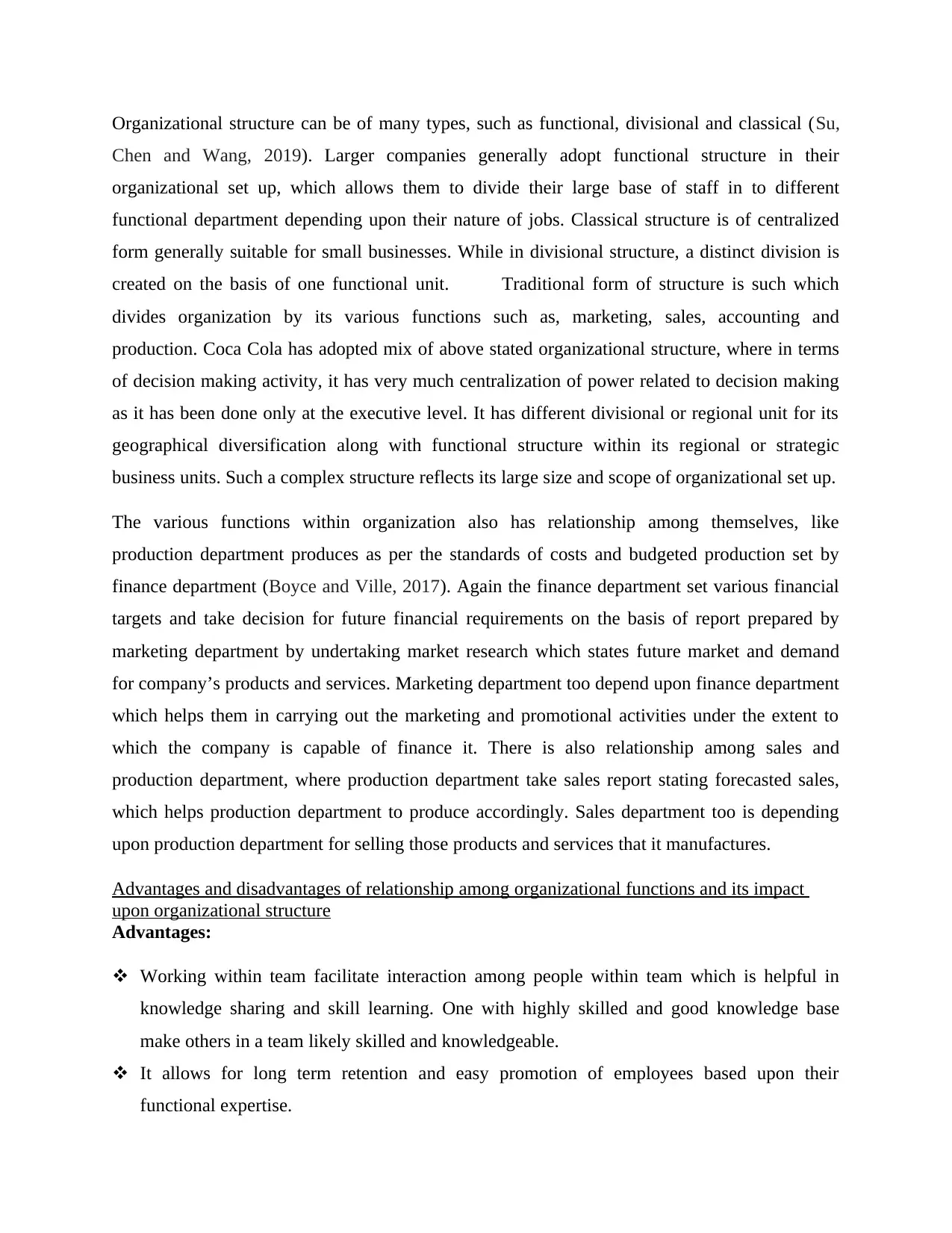
Organizational structure can be of many types, such as functional, divisional and classical (Su,
Chen and Wang, 2019). Larger companies generally adopt functional structure in their
organizational set up, which allows them to divide their large base of staff in to different
functional department depending upon their nature of jobs. Classical structure is of centralized
form generally suitable for small businesses. While in divisional structure, a distinct division is
created on the basis of one functional unit. Traditional form of structure is such which
divides organization by its various functions such as, marketing, sales, accounting and
production. Coca Cola has adopted mix of above stated organizational structure, where in terms
of decision making activity, it has very much centralization of power related to decision making
as it has been done only at the executive level. It has different divisional or regional unit for its
geographical diversification along with functional structure within its regional or strategic
business units. Such a complex structure reflects its large size and scope of organizational set up.
The various functions within organization also has relationship among themselves, like
production department produces as per the standards of costs and budgeted production set by
finance department (Boyce and Ville, 2017). Again the finance department set various financial
targets and take decision for future financial requirements on the basis of report prepared by
marketing department by undertaking market research which states future market and demand
for company’s products and services. Marketing department too depend upon finance department
which helps them in carrying out the marketing and promotional activities under the extent to
which the company is capable of finance it. There is also relationship among sales and
production department, where production department take sales report stating forecasted sales,
which helps production department to produce accordingly. Sales department too is depending
upon production department for selling those products and services that it manufactures.
Advantages and disadvantages of relationship among organizational functions and its impact
upon organizational structure
Advantages:
Working within team facilitate interaction among people within team which is helpful in
knowledge sharing and skill learning. One with highly skilled and good knowledge base
make others in a team likely skilled and knowledgeable.
It allows for long term retention and easy promotion of employees based upon their
functional expertise.
Chen and Wang, 2019). Larger companies generally adopt functional structure in their
organizational set up, which allows them to divide their large base of staff in to different
functional department depending upon their nature of jobs. Classical structure is of centralized
form generally suitable for small businesses. While in divisional structure, a distinct division is
created on the basis of one functional unit. Traditional form of structure is such which
divides organization by its various functions such as, marketing, sales, accounting and
production. Coca Cola has adopted mix of above stated organizational structure, where in terms
of decision making activity, it has very much centralization of power related to decision making
as it has been done only at the executive level. It has different divisional or regional unit for its
geographical diversification along with functional structure within its regional or strategic
business units. Such a complex structure reflects its large size and scope of organizational set up.
The various functions within organization also has relationship among themselves, like
production department produces as per the standards of costs and budgeted production set by
finance department (Boyce and Ville, 2017). Again the finance department set various financial
targets and take decision for future financial requirements on the basis of report prepared by
marketing department by undertaking market research which states future market and demand
for company’s products and services. Marketing department too depend upon finance department
which helps them in carrying out the marketing and promotional activities under the extent to
which the company is capable of finance it. There is also relationship among sales and
production department, where production department take sales report stating forecasted sales,
which helps production department to produce accordingly. Sales department too is depending
upon production department for selling those products and services that it manufactures.
Advantages and disadvantages of relationship among organizational functions and its impact
upon organizational structure
Advantages:
Working within team facilitate interaction among people within team which is helpful in
knowledge sharing and skill learning. One with highly skilled and good knowledge base
make others in a team likely skilled and knowledgeable.
It allows for long term retention and easy promotion of employees based upon their
functional expertise.
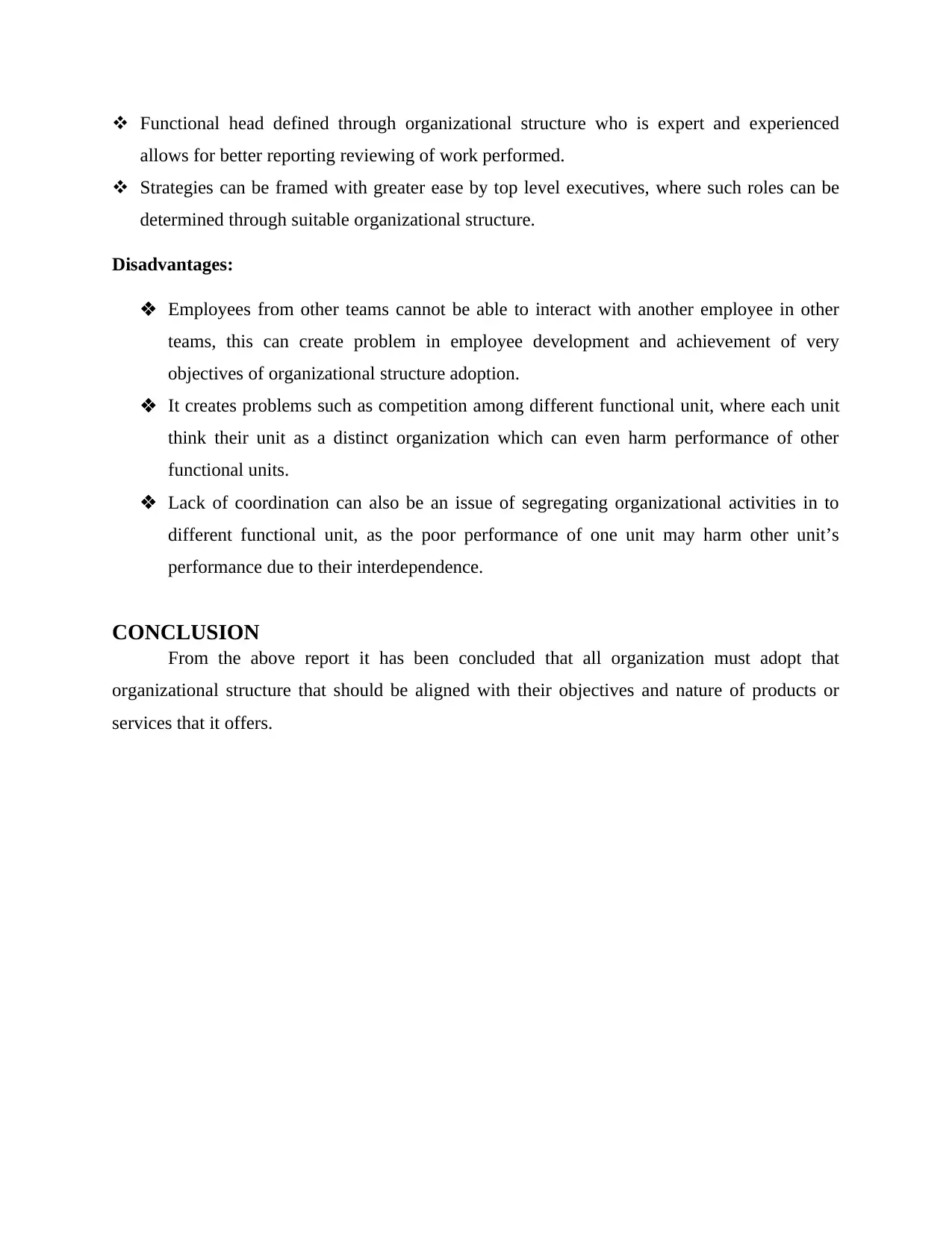
Functional head defined through organizational structure who is expert and experienced
allows for better reporting reviewing of work performed.
Strategies can be framed with greater ease by top level executives, where such roles can be
determined through suitable organizational structure.
Disadvantages:
Employees from other teams cannot be able to interact with another employee in other
teams, this can create problem in employee development and achievement of very
objectives of organizational structure adoption.
It creates problems such as competition among different functional unit, where each unit
think their unit as a distinct organization which can even harm performance of other
functional units.
Lack of coordination can also be an issue of segregating organizational activities in to
different functional unit, as the poor performance of one unit may harm other unit’s
performance due to their interdependence.
CONCLUSION
From the above report it has been concluded that all organization must adopt that
organizational structure that should be aligned with their objectives and nature of products or
services that it offers.
allows for better reporting reviewing of work performed.
Strategies can be framed with greater ease by top level executives, where such roles can be
determined through suitable organizational structure.
Disadvantages:
Employees from other teams cannot be able to interact with another employee in other
teams, this can create problem in employee development and achievement of very
objectives of organizational structure adoption.
It creates problems such as competition among different functional unit, where each unit
think their unit as a distinct organization which can even harm performance of other
functional units.
Lack of coordination can also be an issue of segregating organizational activities in to
different functional unit, as the poor performance of one unit may harm other unit’s
performance due to their interdependence.
CONCLUSION
From the above report it has been concluded that all organization must adopt that
organizational structure that should be aligned with their objectives and nature of products or
services that it offers.
⊘ This is a preview!⊘
Do you want full access?
Subscribe today to unlock all pages.

Trusted by 1+ million students worldwide
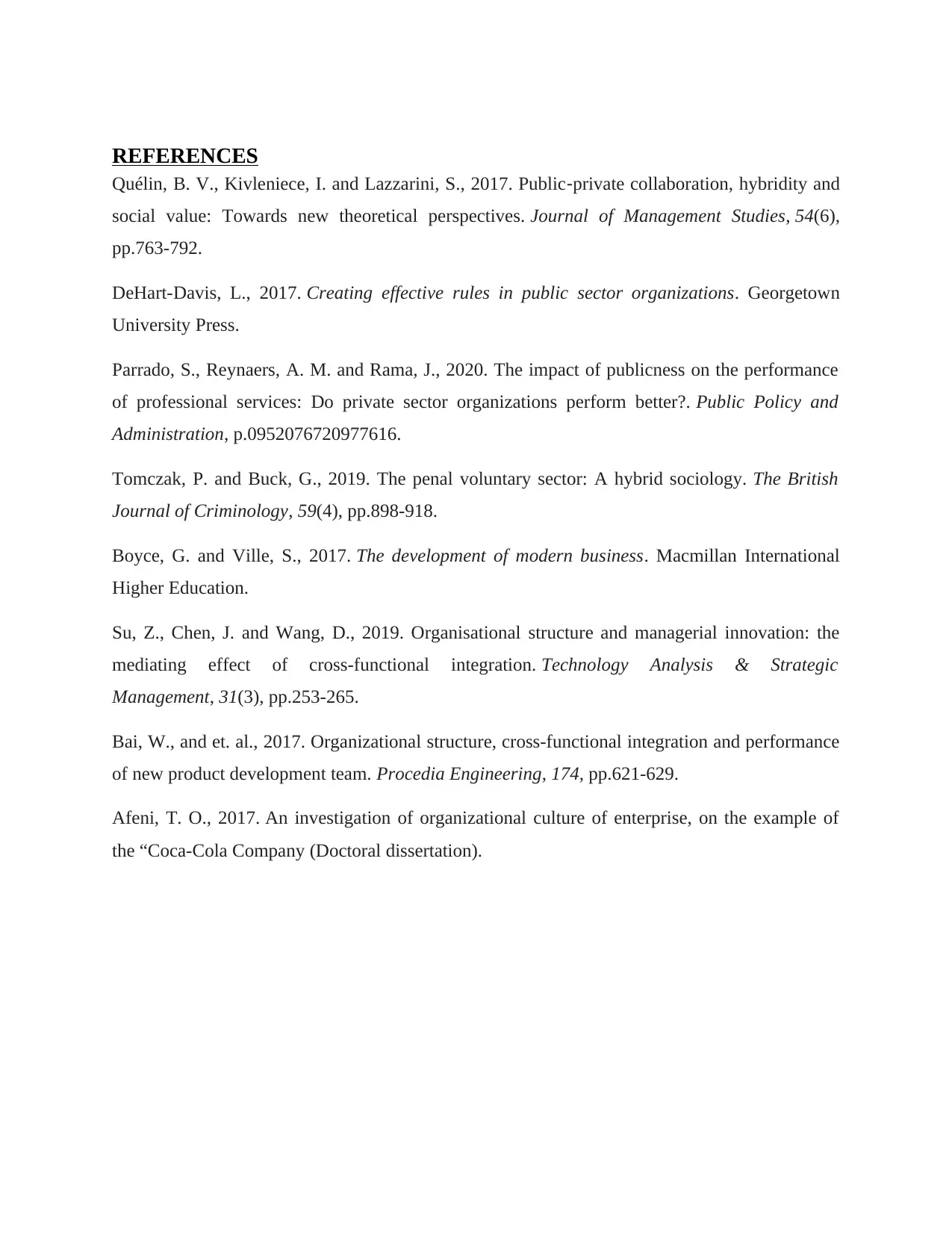
REFERENCES
Quélin, B. V., Kivleniece, I. and Lazzarini, S., 2017. Public‐private collaboration, hybridity and
social value: Towards new theoretical perspectives. Journal of Management Studies, 54(6),
pp.763-792.
DeHart-Davis, L., 2017. Creating effective rules in public sector organizations. Georgetown
University Press.
Parrado, S., Reynaers, A. M. and Rama, J., 2020. The impact of publicness on the performance
of professional services: Do private sector organizations perform better?. Public Policy and
Administration, p.0952076720977616.
Tomczak, P. and Buck, G., 2019. The penal voluntary sector: A hybrid sociology. The British
Journal of Criminology, 59(4), pp.898-918.
Boyce, G. and Ville, S., 2017. The development of modern business. Macmillan International
Higher Education.
Su, Z., Chen, J. and Wang, D., 2019. Organisational structure and managerial innovation: the
mediating effect of cross-functional integration. Technology Analysis & Strategic
Management, 31(3), pp.253-265.
Bai, W., and et. al., 2017. Organizational structure, cross-functional integration and performance
of new product development team. Procedia Engineering, 174, pp.621-629.
Afeni, T. O., 2017. An investigation of organizational culture of enterprise, on the example of
the “Coca-Cola Company (Doctoral dissertation).
Quélin, B. V., Kivleniece, I. and Lazzarini, S., 2017. Public‐private collaboration, hybridity and
social value: Towards new theoretical perspectives. Journal of Management Studies, 54(6),
pp.763-792.
DeHart-Davis, L., 2017. Creating effective rules in public sector organizations. Georgetown
University Press.
Parrado, S., Reynaers, A. M. and Rama, J., 2020. The impact of publicness on the performance
of professional services: Do private sector organizations perform better?. Public Policy and
Administration, p.0952076720977616.
Tomczak, P. and Buck, G., 2019. The penal voluntary sector: A hybrid sociology. The British
Journal of Criminology, 59(4), pp.898-918.
Boyce, G. and Ville, S., 2017. The development of modern business. Macmillan International
Higher Education.
Su, Z., Chen, J. and Wang, D., 2019. Organisational structure and managerial innovation: the
mediating effect of cross-functional integration. Technology Analysis & Strategic
Management, 31(3), pp.253-265.
Bai, W., and et. al., 2017. Organizational structure, cross-functional integration and performance
of new product development team. Procedia Engineering, 174, pp.621-629.
Afeni, T. O., 2017. An investigation of organizational culture of enterprise, on the example of
the “Coca-Cola Company (Doctoral dissertation).
1 out of 10
Related Documents
Your All-in-One AI-Powered Toolkit for Academic Success.
+13062052269
info@desklib.com
Available 24*7 on WhatsApp / Email
![[object Object]](/_next/static/media/star-bottom.7253800d.svg)
Unlock your academic potential
Copyright © 2020–2025 A2Z Services. All Rights Reserved. Developed and managed by ZUCOL.




